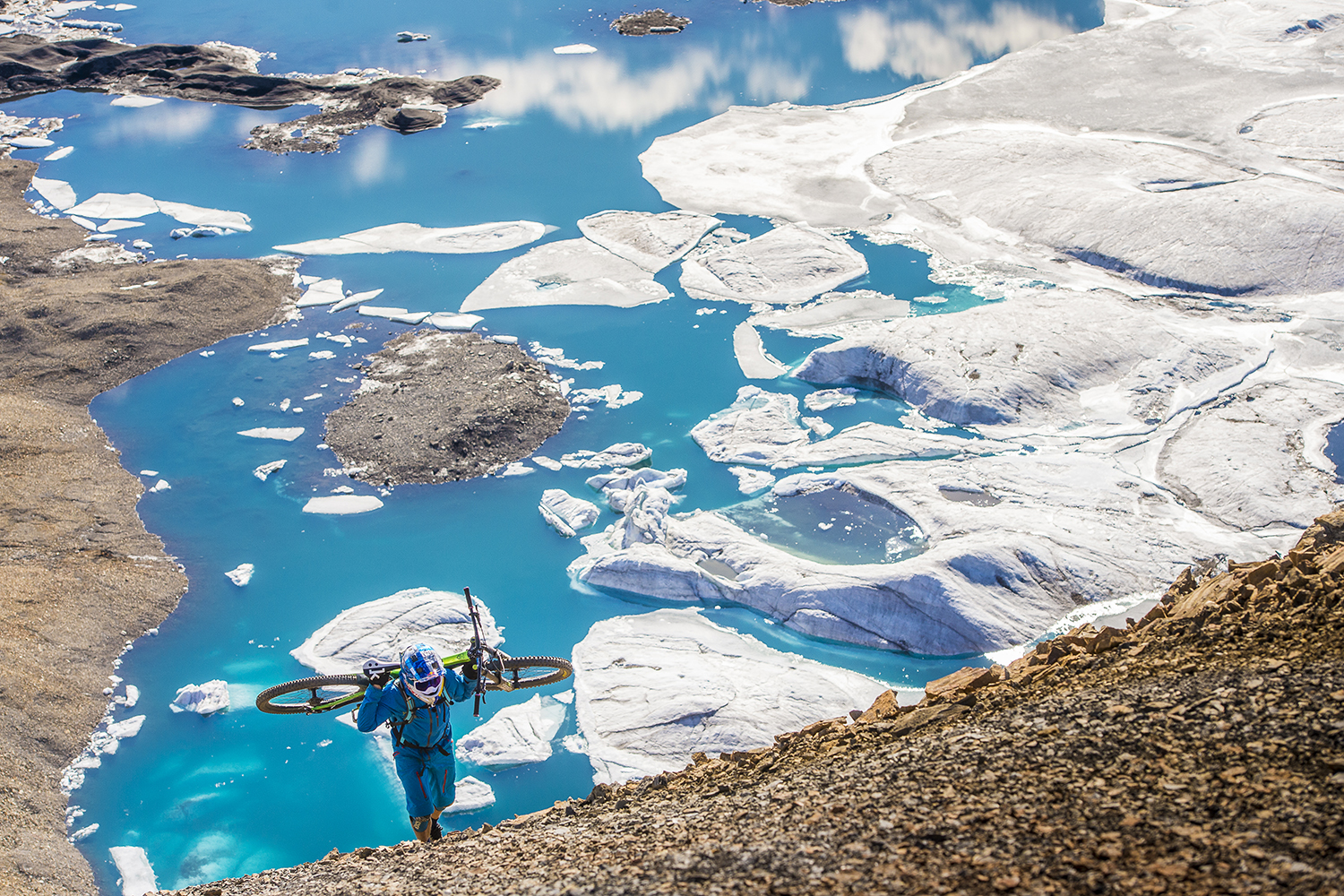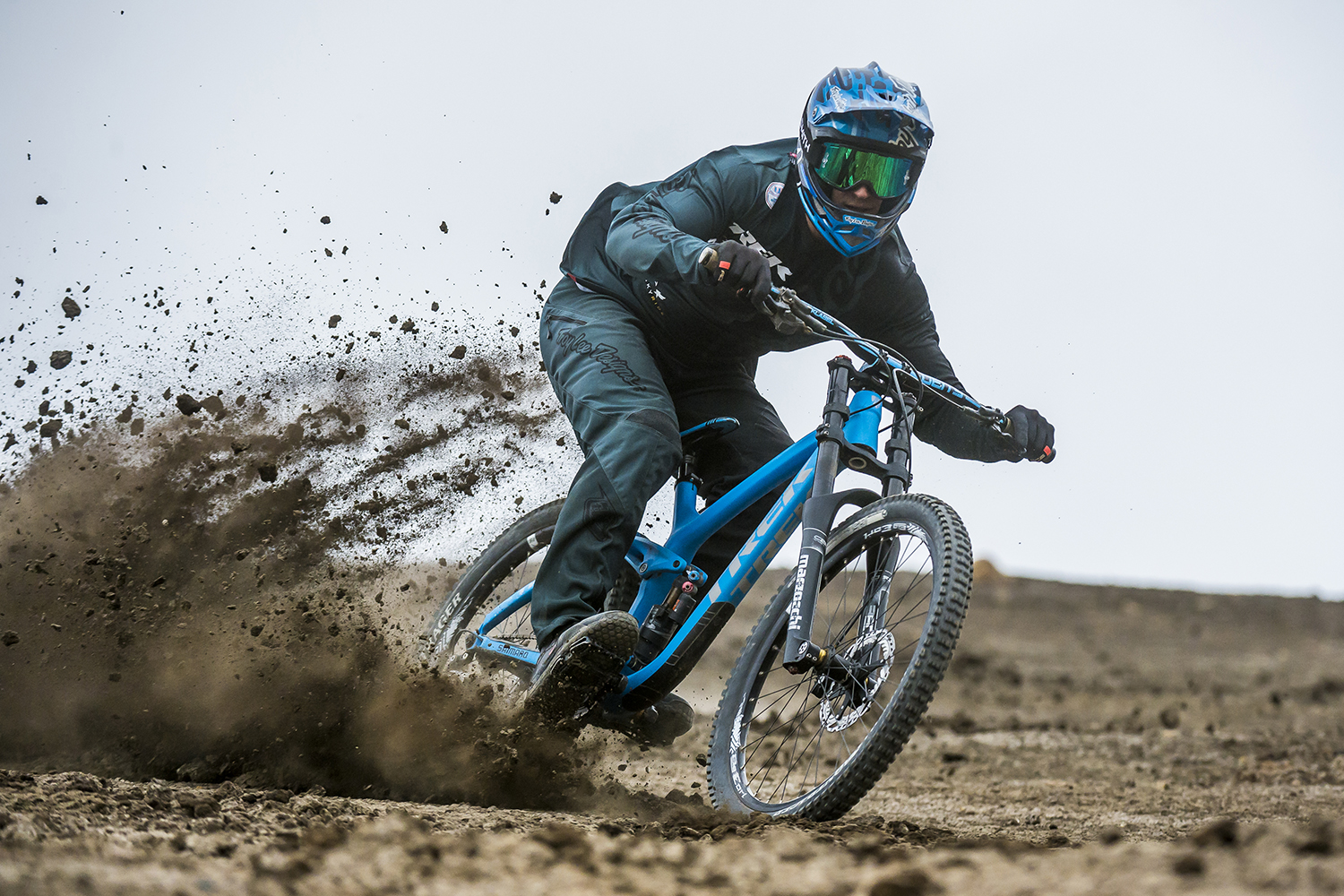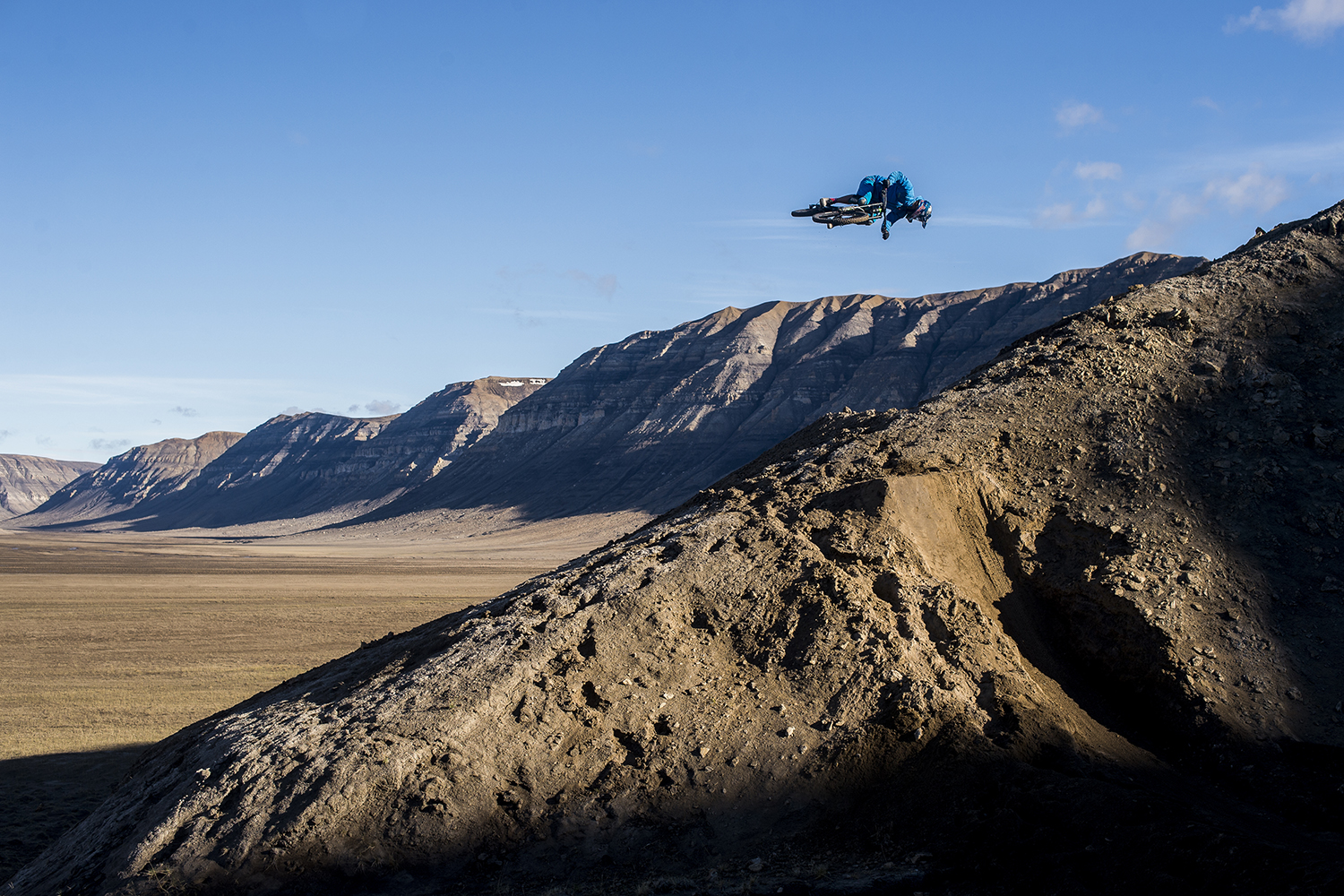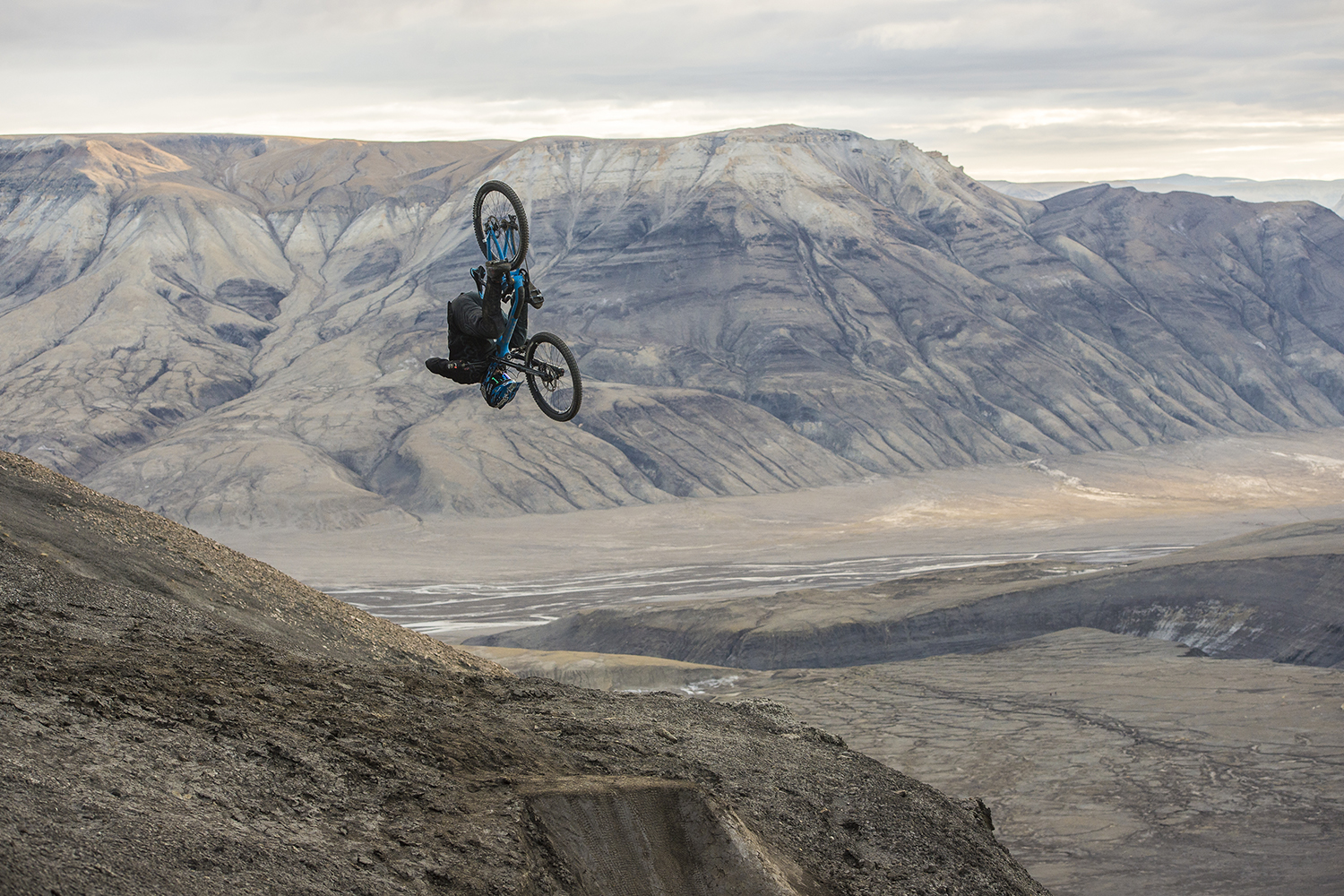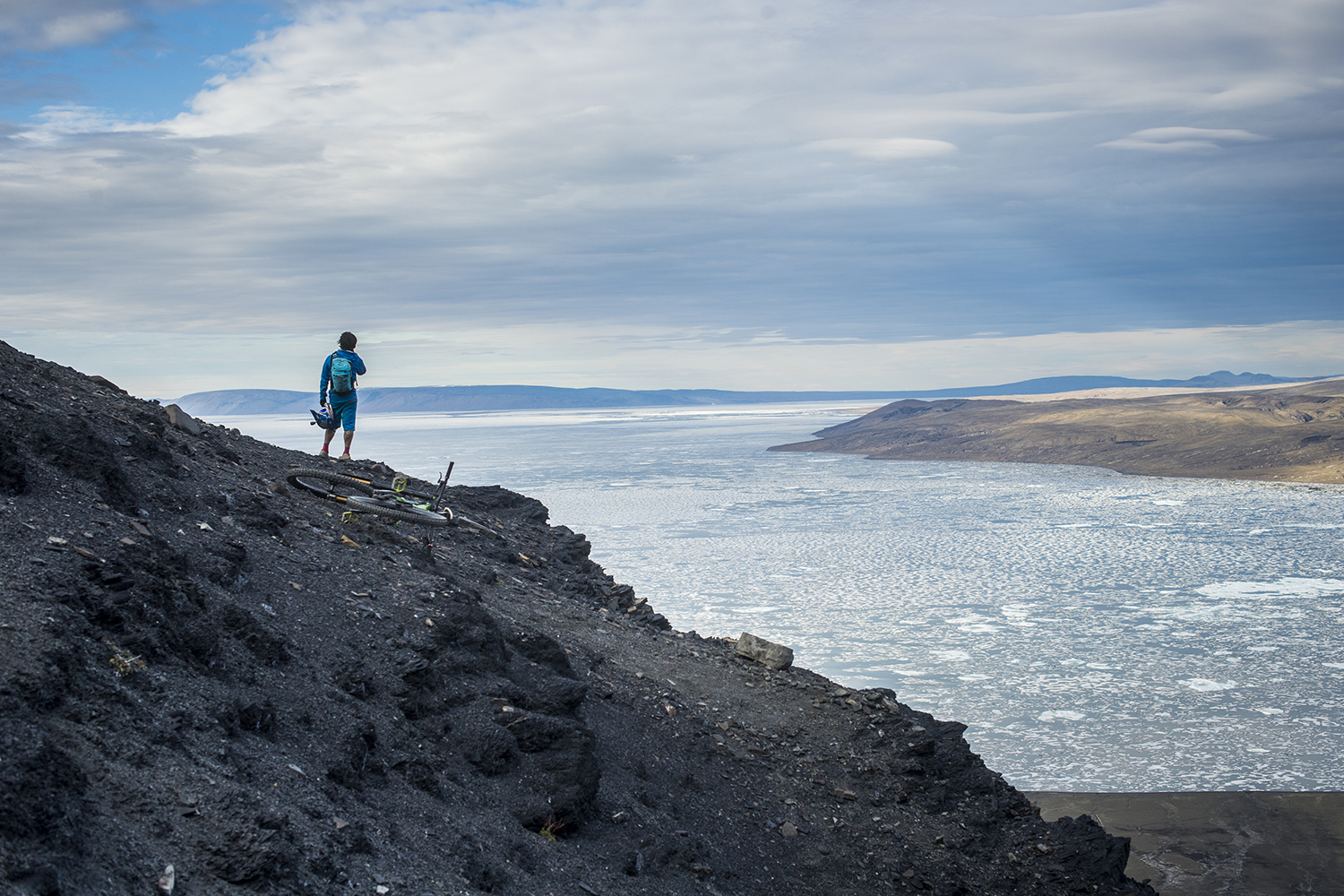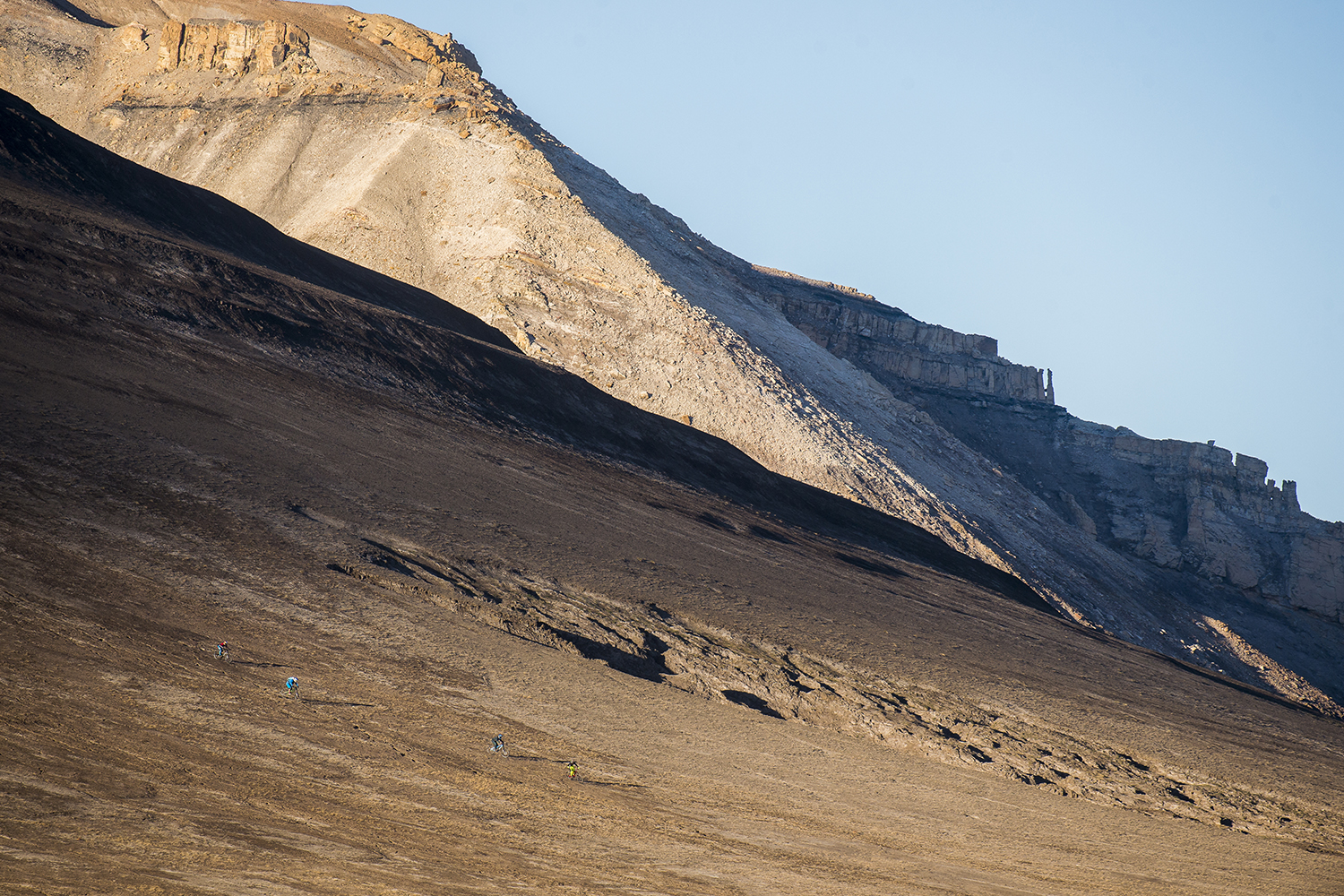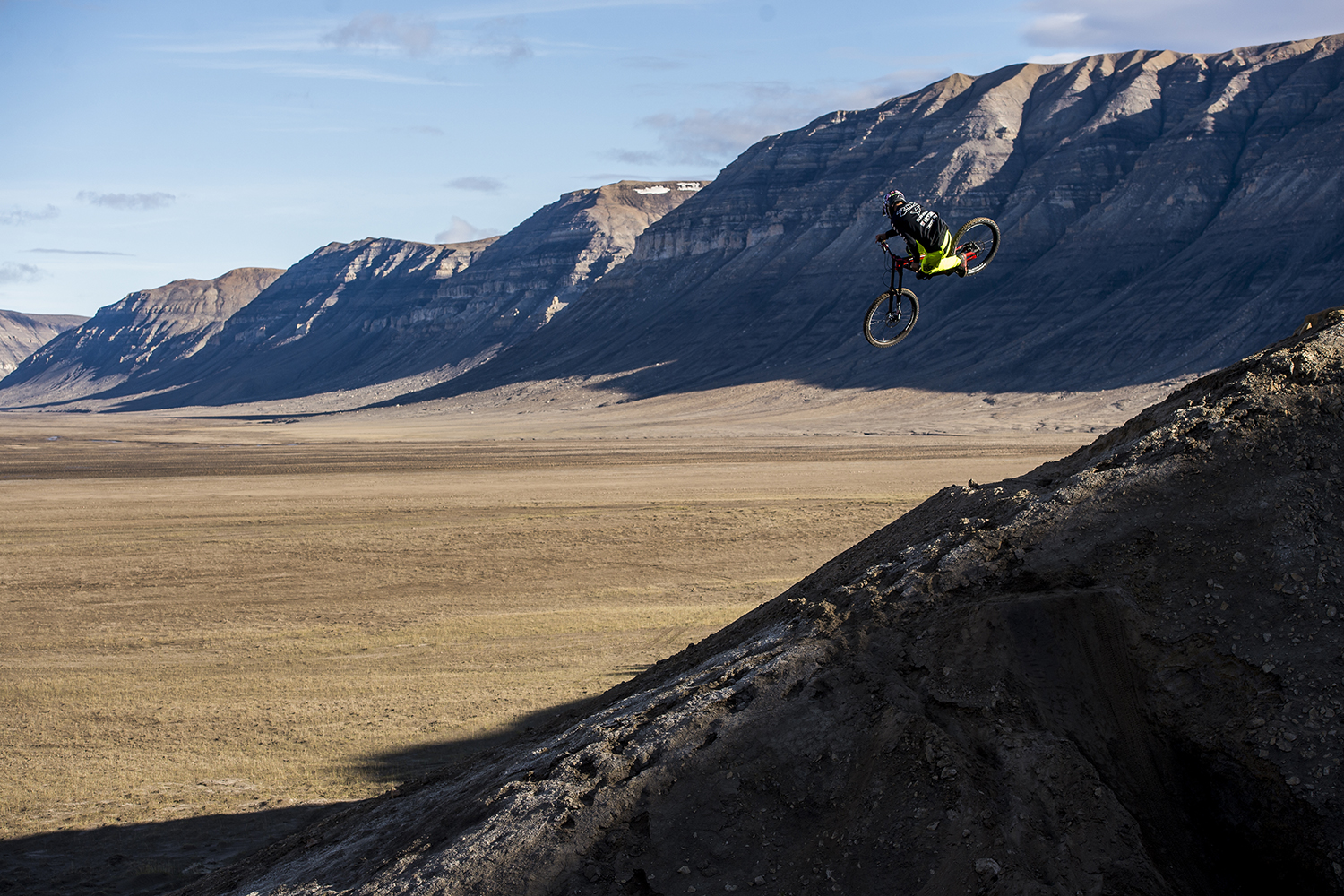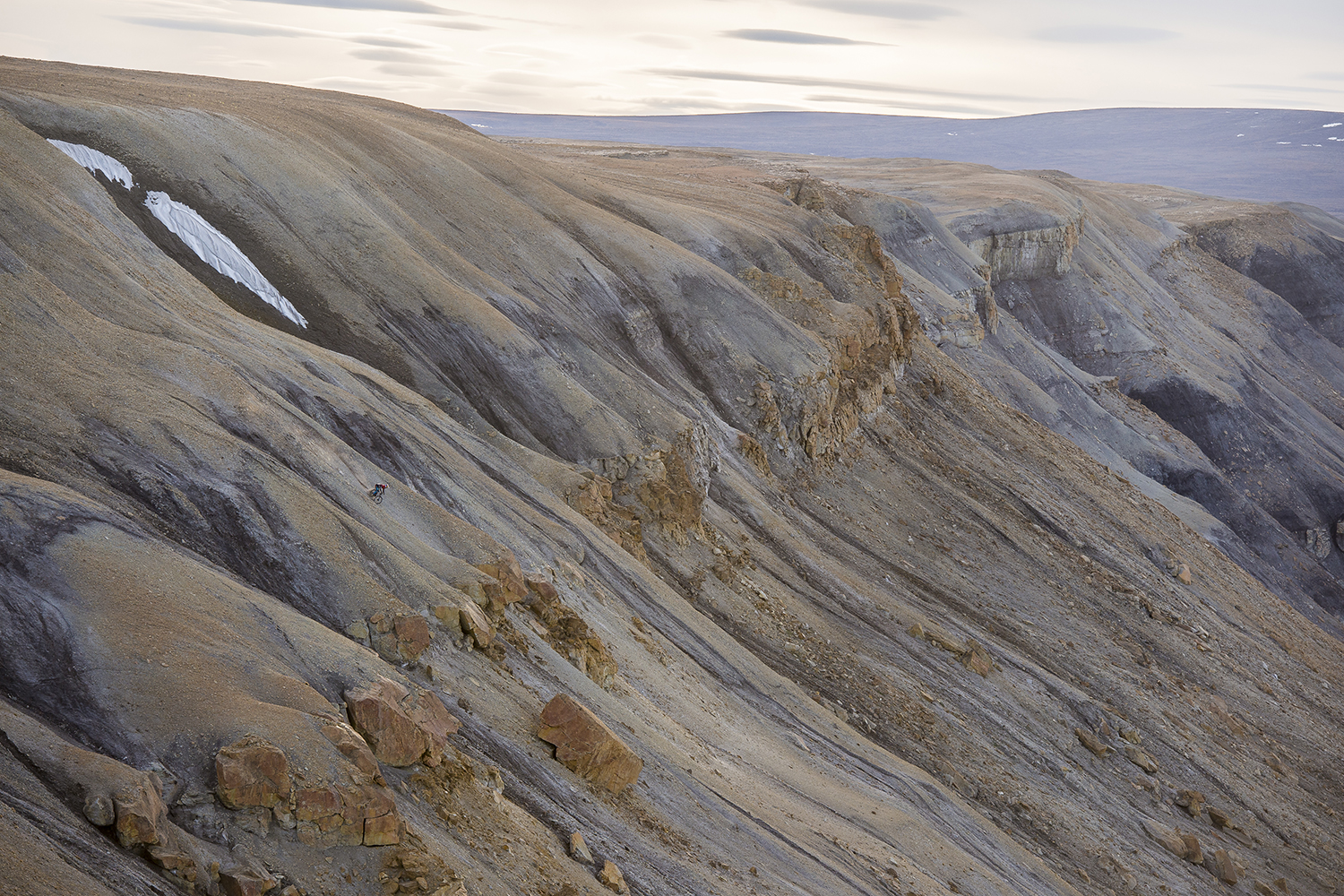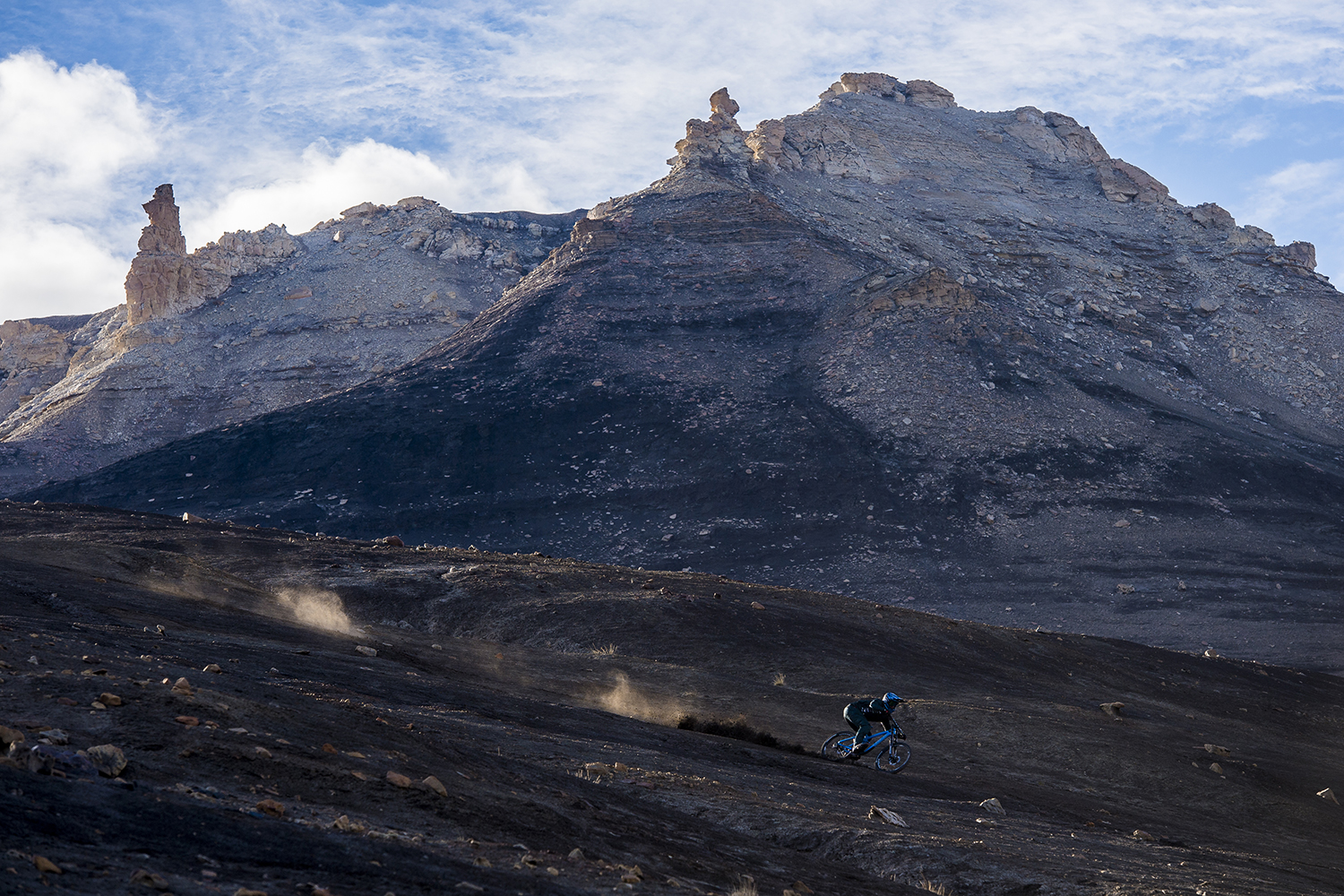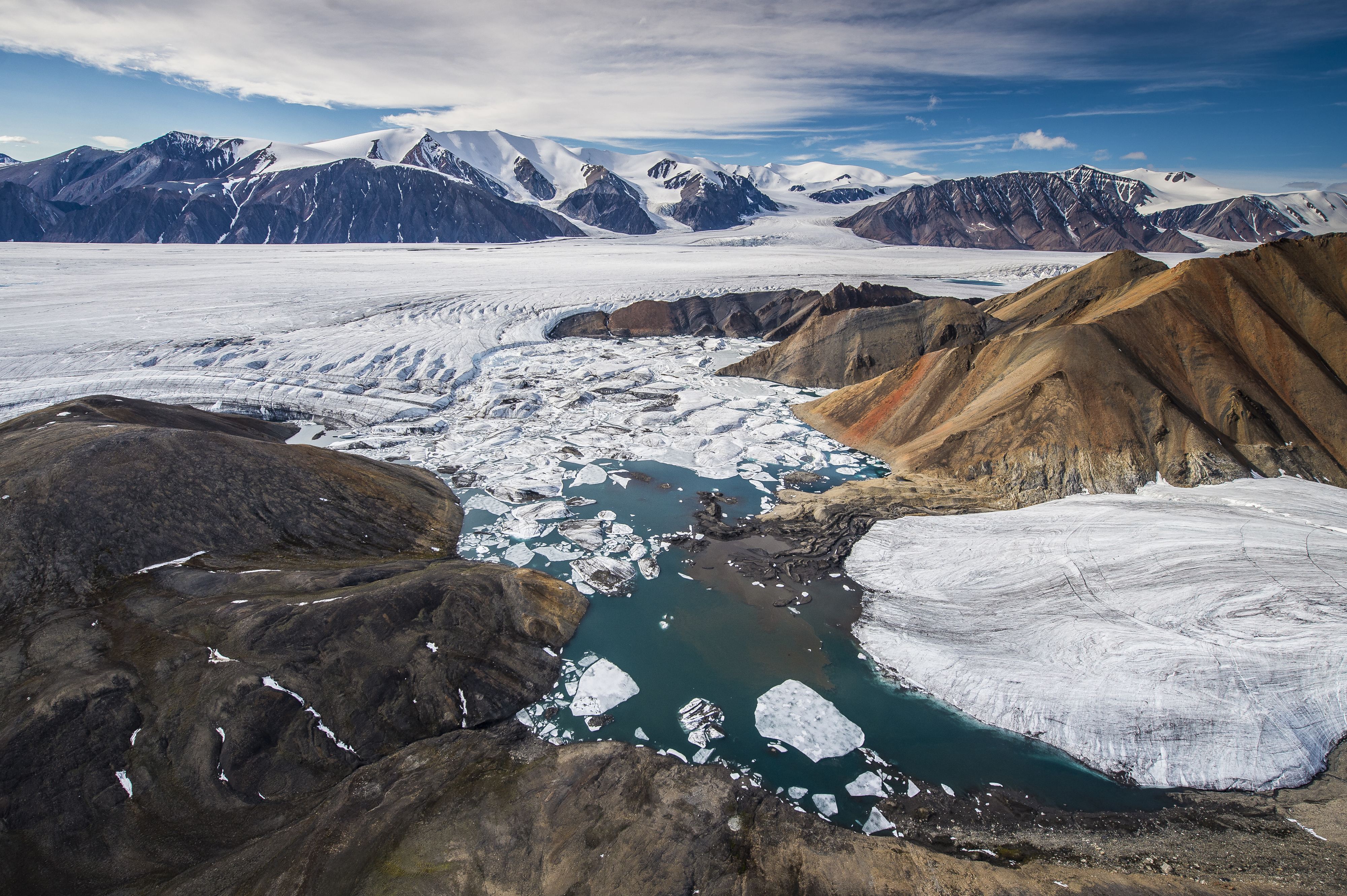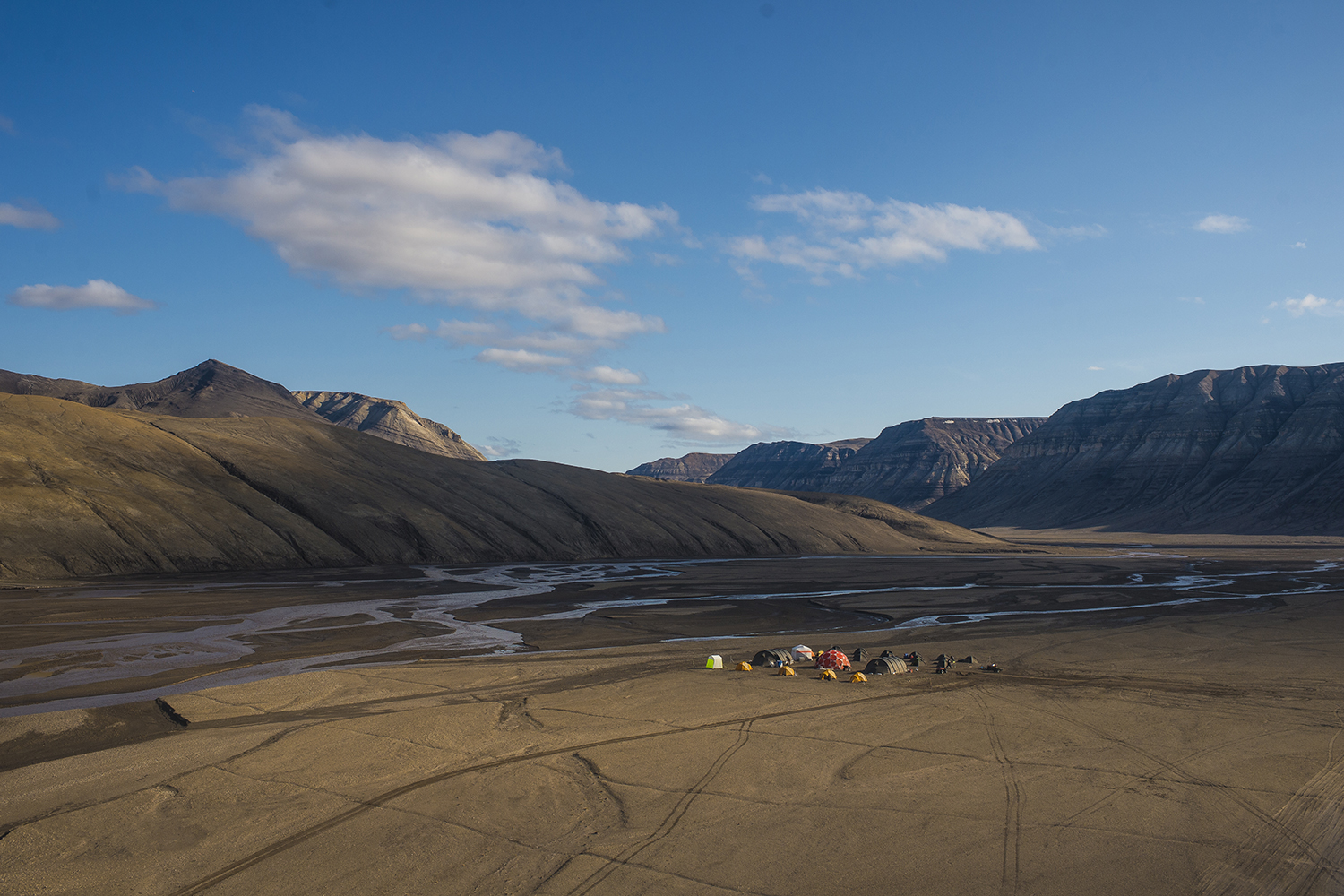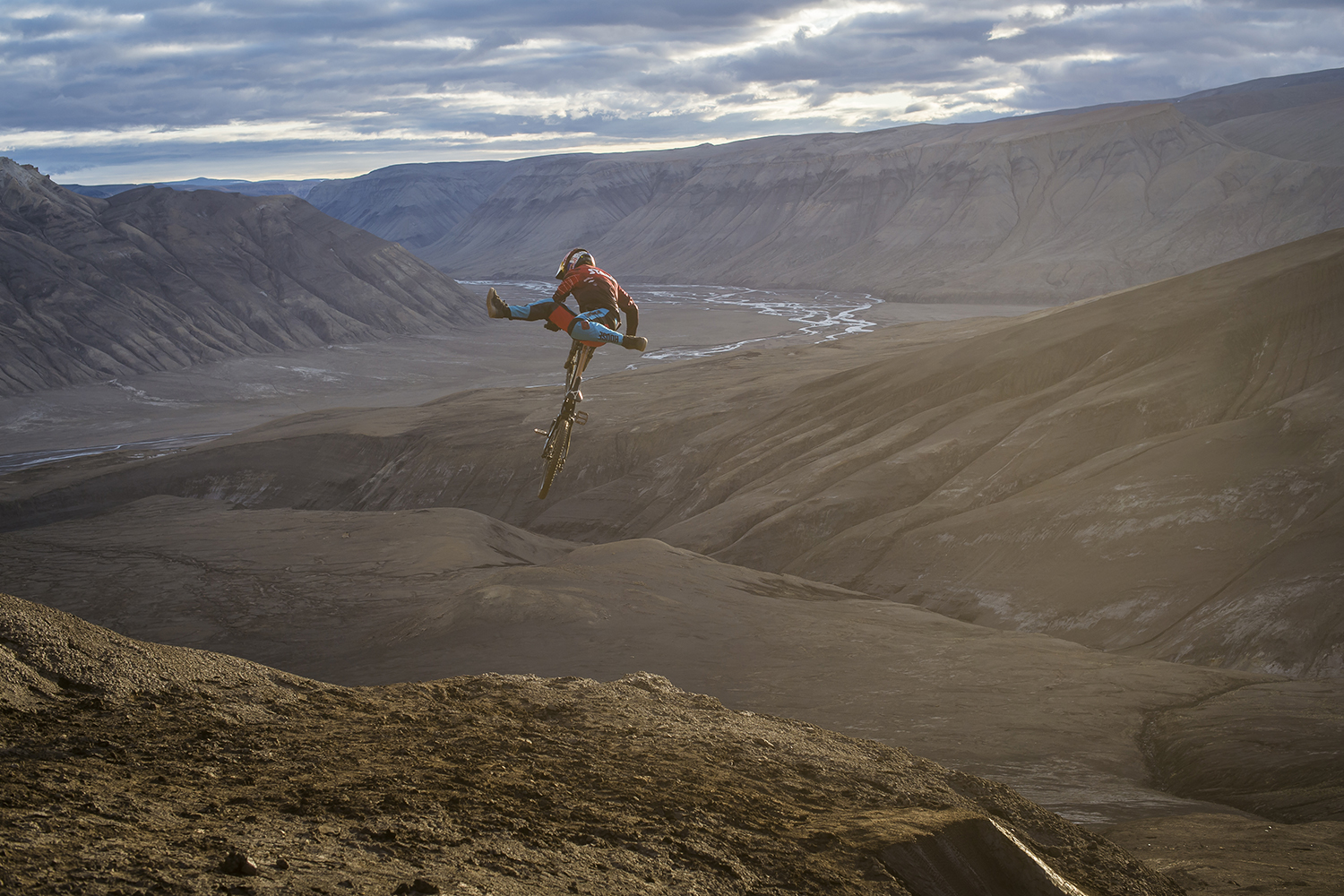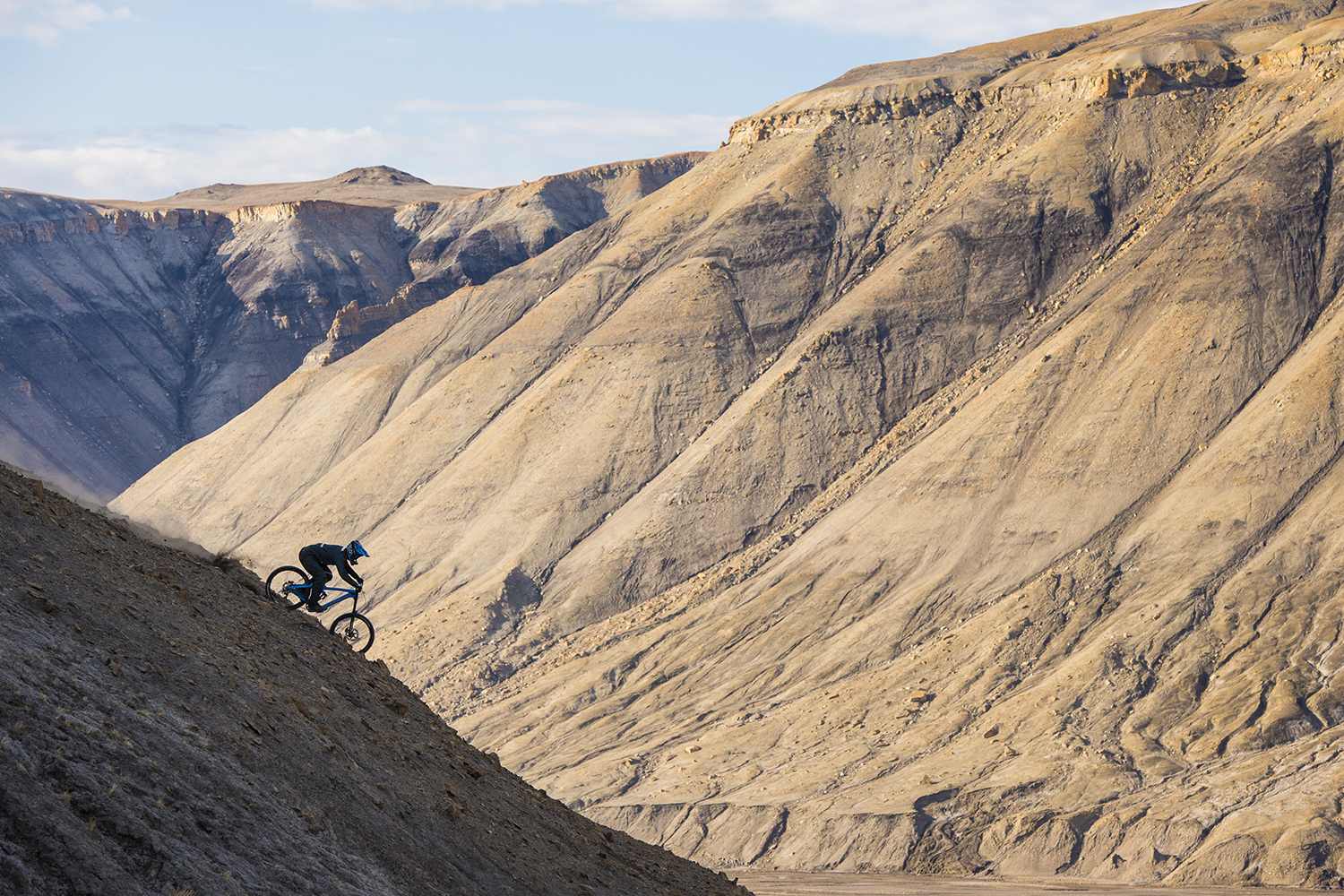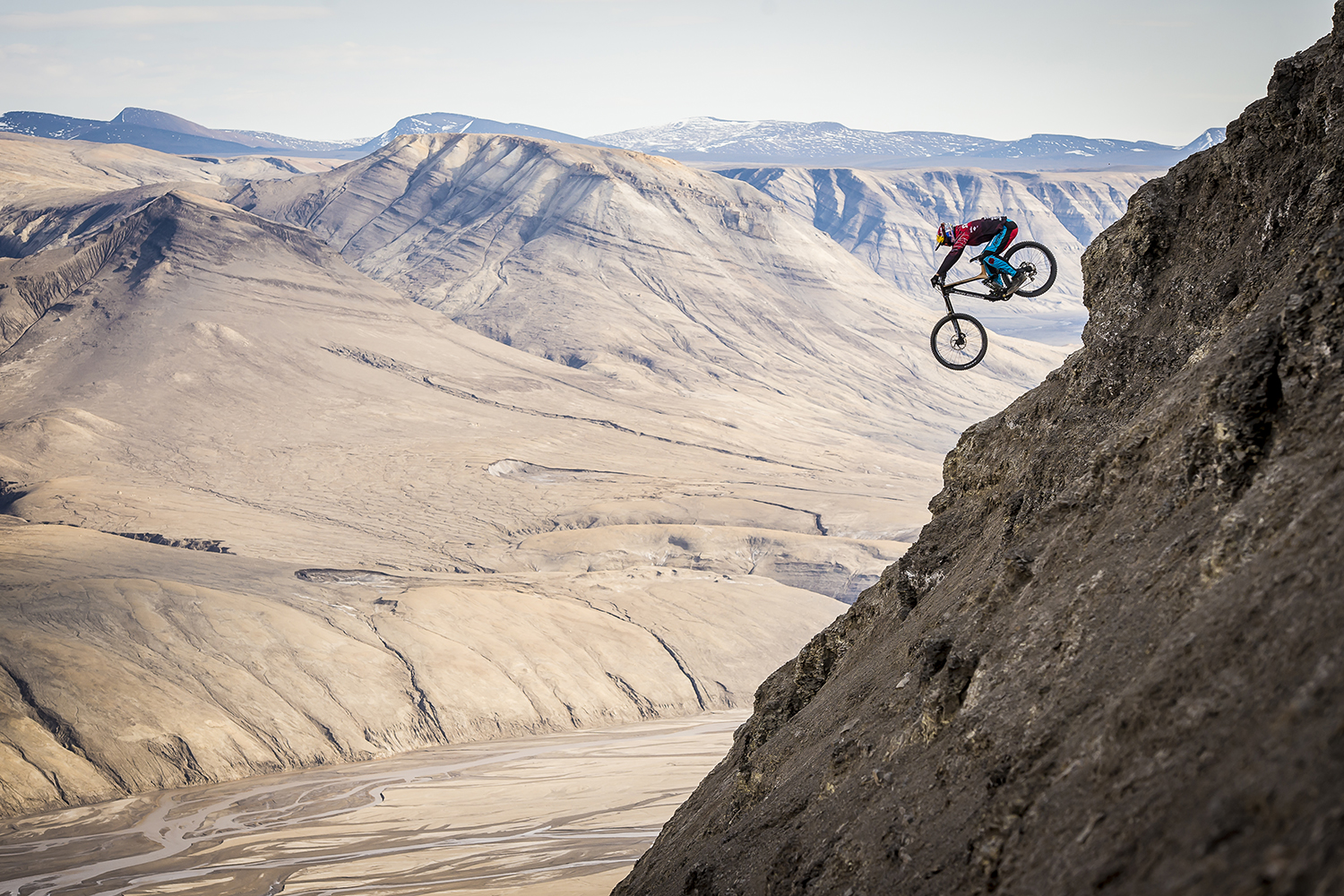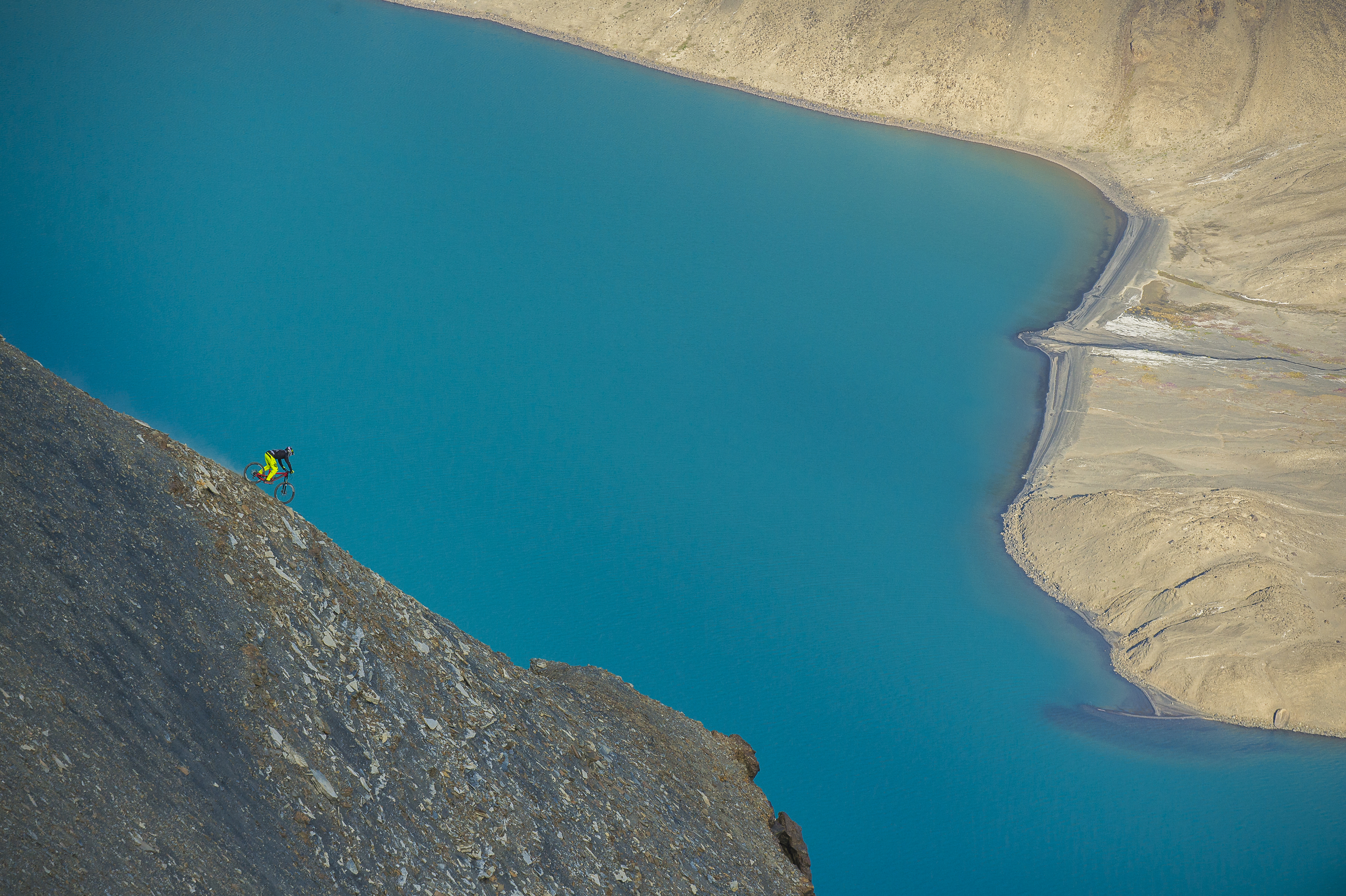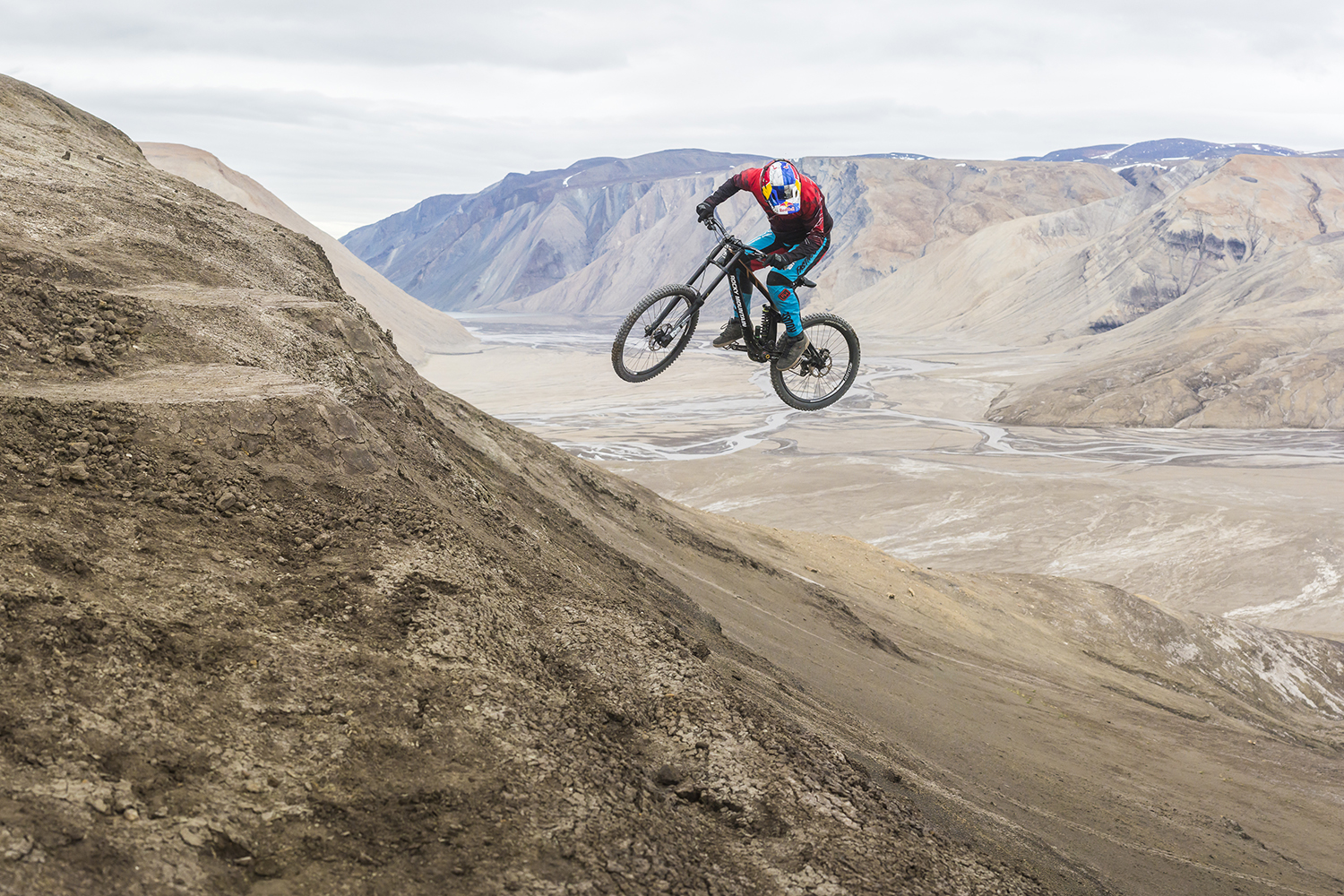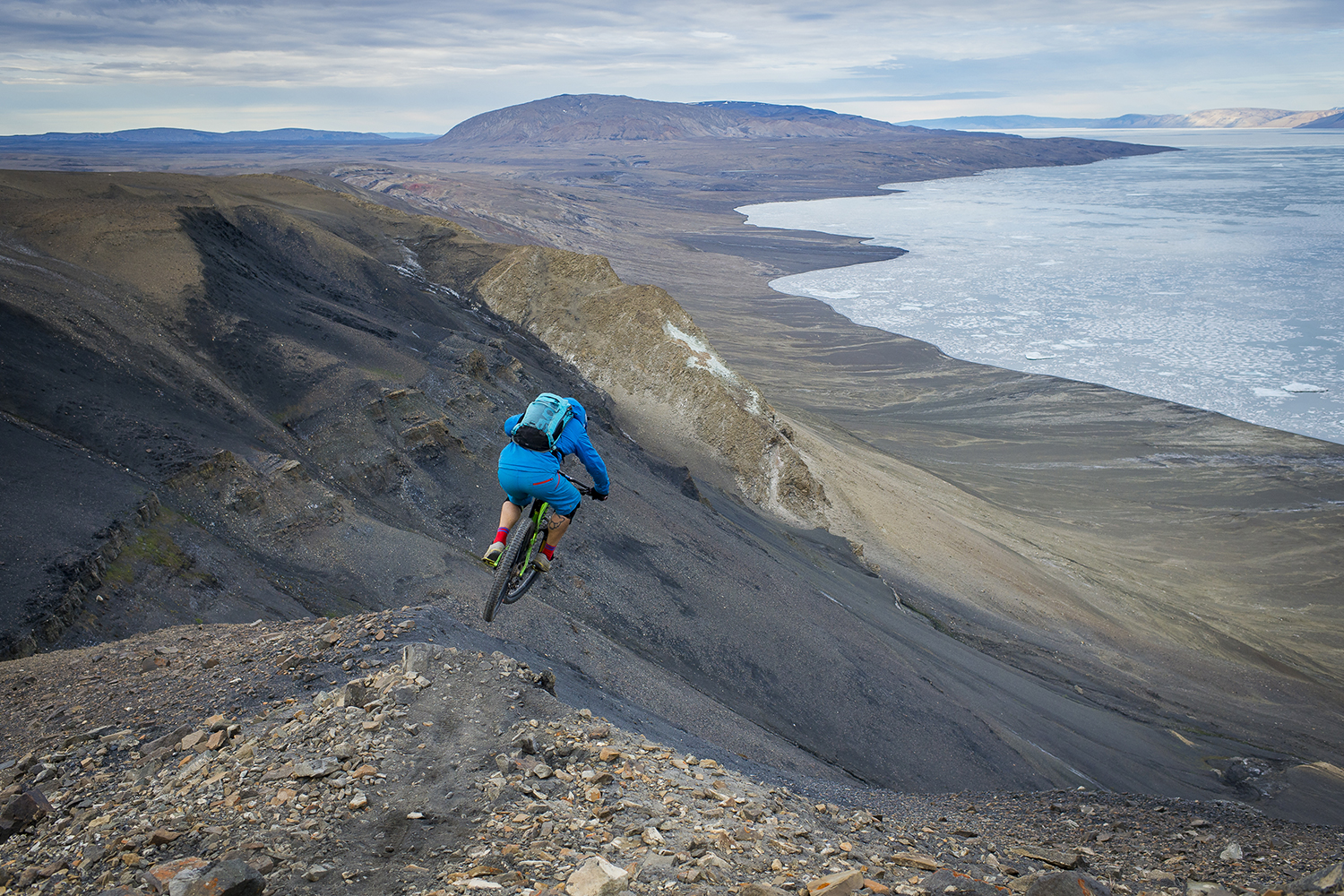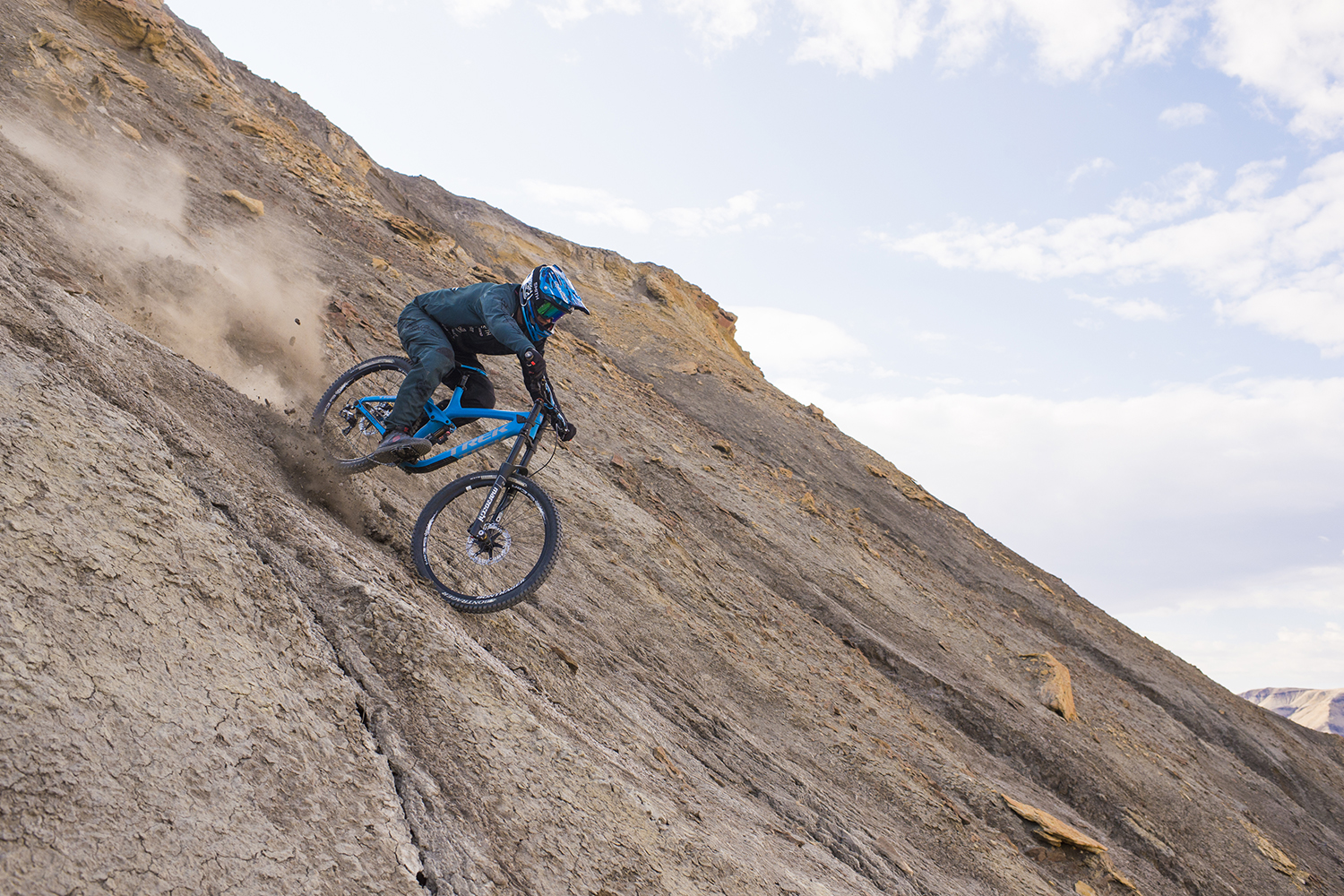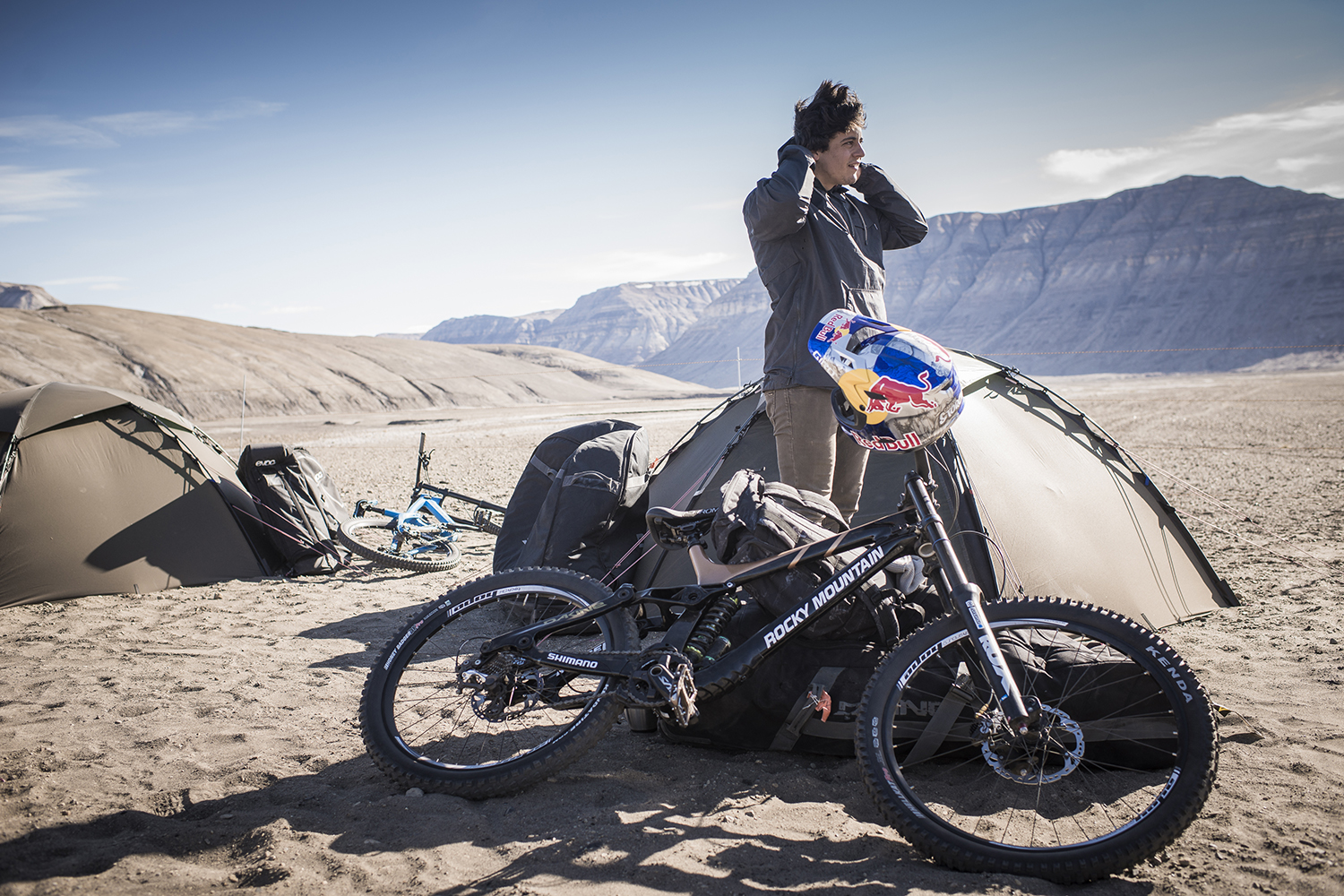Near the tip of the Canadian Arctic Archipelago, some 750 miles farther north of where Sir John Franklin’s fabled 1845 Arctic expedition met its end, and just a stone’s throw from the magnetic north pole, lies Axel Heiberg island. Scattered wolves, foxes, and muskoxen roam its surface along with the occasional polar bear, while beluga whales and narwhals swim in the frigid waters that surround it. In the winter, the sun doesn’t rise for four months, but the summer brings 24 hours of daylight — and a cinematographer’s dream of uninterrupted “golden hour.”
This seems like a latitude more favorable to snowboarding than bike riding, but due to the extreme low temperatures that keep the surrounding ocean frozen most of the year, Axel Heiberg sees little precipitation. What you might expect to be a snow-covered wonderland is actually closer to a desert. This is why director Jeremy Grant and the crew at Freeride Entertainment chose it for their latest mountain bike film, North of Nightfall. Produced in partnership with Red Bull Media House, the film follows professional riders Darren Berrecloth, Cam Zink, Carson Storch, and Tom van Steenbergen as they take on terrain never before touched by the tires of a bike — a challenge that would push them to their limits, and beyond.
An unforgiving location, an uncompromising vision
The film, which released on June 5, is about the location as much as the athletes, wrapping in the geological and human history of Axel Heiberg in a series of beautifully drawn, monochromatic animations that serve as chapter lead-ins. It’s part of a new wave of action sport cinema that includes movies like Travis Rice’s The Fourth Phase, films that search for a deeper meaning beyond the spectacle of athletics, while attempting to connect it to a coherent story and giving it a presentation that rivals the best that Hollywood, the BBC, or National Geographic have to offer.
“These stories are traditionally about the landscape, but I wanted to make this a human story.”
Such an approach is a balancing act, needing to appeal both to hardcore extreme sports fans — frothing at the mouth for ever bigger tricks — and the more casual, but much larger, general audience. If you come to Nightfall expecting a supercut of Red Bull Rampage-style tricks, you may be disappointed — but that would be on you. This is sure to be one of the most unique sports documentaries of the year, with every aspect of it expertly crafted, from the cinematography, to the editing, to the score. Aside from a few bits of dialogue that feel slightly forced and the film’s closing message about climate change — not unimportant, but a bit on the nose — Nightfall does a better job than most of seamlessly wrapping narrative, history, and edge-of-your-seat excitement into its 1-hour-and-5-minute runtime.
This is partly due to how the film is presented without any talking head interviews. All of the dialogue is captured via lapel microphones worn by the cast at all times, and while a few bits here and there feel rehearsed, the overall result is something akin to an observational documentary. The scenes flow together effortlessly, and the human interest components are kept just short enough to avoid feeling manufactured. There’s an identifiable pattern to the action sequences that starts with build-up and tension, moves into awe, then to terror, and finally ends with humor. It repeats often, but it works, and we always get just the right amount of each emotion.
It also doesn’t hurt that the film is absolutely gorgeous to look at from start to finish. To learn more about how it was made, we sat down with director Jeremy Grant at the film’s premiere in Bend, Oregon last month to discover how he achieved such an uncompromising cinematic vision in such a desolate, unforgiving location.
Island hopping
The first chapter of the film takes place in Berrecloth’s home of Vancouver Island, British Columbia. The environment presents a stark contrast to that of the rest of the film, with dense forests of towering evergreens sliced by swift singletrack. Here, Grant pulled out one of Freeride’s original tricks: The cable cam. Specially, a Defy Dactylcam attached to a Freefly Movi gimbal operated remotely via Freefly’s Mimic controller, which allows the camera operator to pan and tilt the remote camera with natural movements, as if using the camera on a tripod.
The scenes here serve as an introduction to the characters and establish a baseline for the sport — but all expectations are thrown out the window in the next chapter as the team packs up and heads north, trading the lush greens of Vancouver Island for the Martian reds and grays of Axel Heiberg. Though both are part of Canada, the two islands couldn’t be more different.
Over the eons, Axel Heiberg’s nearly 2,000 glaciers have carved their mark, leaving in their wakes shale-covered slopes thousands of feet high. This far north, there are no trees and what vegetation exists is scarce. It was in photos of these rocky peaks that Grant and Berrecloth first saw opportunity: Bike lines longer than any ridden before, in an alien landscape that few people had ever seen, let alone visited. It would be a first not just for mountain biking, but also for filmmaking.
“If you put new tools in people’s hands, those limitations will actually push them to do unique things.”
“This one checked all the boxes,” Grant told Digital Trends. “It’s an uninhabited island the size of Switzerland just south of the North Pole, so that is just irresistible from an adventure standpoint.”
Although once inhabited by an ancestral Inuit people called the Thule, one of Axel Heiberg’s most defining statistics today is its human population count: Zero. A semi-permanent research station was erected in 1960 to study the glaciers and the effects of climate change, a practice that continues today in the hands of Dr. Laura Thompson, a glaciologist featured in the film, and one of a very small handful of people to return to the island regularly. When Berrecloth, Zink, Storch, and van Steenbergen stepped off the plane, they weren’t just freeride mountain bikers; they were explorers.
The island can be reached only by a privately chartered plane, which has to land directly on the tundra as there are no airstrips. Being so remote, with no internet, no local emergency services, and just a short window of time during which temperatures, weather conditions, and sunlight are suitable, filming on Axel Heiberg was no small undertaking. The crew had to pack in everything they needed, including enough dehydrated food to last nearly three weeks. And with four riders, seven bikes, spare parts, and other gear, room for camera equipment would be limited.
Yet despite these challenges, Grant’s vision called for very specific production gear; namely, RED digital cinema cameras and Cooke anamorphic lenses — heavy, Hollywood-caliber tools. This isn’t what would normally be expected for this type of documentary production, which traditionally would benefit from a lightweight, run-and-gun style setup. But Grant said the Anamorphic lenses were a must-have.
“To have the sun sitting on the horizon dancing around you is a cinematographer’s dream.”
Where a normal, spherical photographic lens captures an equal field of view in both axes, an anamorphic lens is wider in the horizontal axis than the vertical. This makes the lens larger, and results in footage that needs to be “de-squeezed” in post, but is responsible for the characteristic widescreen look used in Hollywood for decades. Anamorphic lenses seem naturally suited for capturing large vistas, and the unique lens flares they produce were something Grant wanted to take advantage of in the Arctic Circle’s 24 hours of daylight. Beyond this, anamorphic lenses render a shallower depth of field than an equally wide spherical lens, better able to separate foreground and background, making them great for human subjects. After the de-squeeze process, they also yield a slightly softer image, which is often desirable for facial details like skin.
“These stories are traditionally about the landscape, but I wanted to make this a human story, and I love how the [Cooke lenses] portray the human face,” Grant said. It’s the same reason that Cooke anamorphic lenses were used in Blood Road, another Red Bull Media House film, which, coincidentally, is also about mountain biking.

But there was also a deeper reason for going with such complex gear. “If you give everyone the same thing they’ve always shot, you’re probably going to end up with the same film you’ve done before,” said Grant. “If you put new tools in people’s hands, those limitations will actually push them to do unique things, which will make the film different — which is kind of harder and harder [to do] in today’s landscape.”
Beyond the character that anamorphic lenses would bring to the film, Grant knew the aerial perspective would be critical to showcasing the scale of the location. But there was one big problem: That close to the magnetic north pole, the navigation systems inside small UAVs go haywire. During the location scout, the team sent a DJI Phantom 4 into the air, only to watch it dive into a rock after 5 minutes of erratic flight. At that point, they knew they would have to rely on a helicopter for aerials, which came with a much higher price tag.
The helicopter was equipped with a Cineflex system, essentially a robust gimbal capable of stabilizing a large camera and lens. It was outfitted with a Canon 30-300mm cinema zoom. One other non-anamorphic zoom lens was used on the ground: The massive Canon 50-1000mm Cine-Servo, which, in case you happen to be in the market, sells for just over $70,000.
With the 30-300mm in the air, the 50-1000mm “on a massive set of sticks” on the ground, one to two additional cameras with anamorphic lenses, and, naturally, action cams on every rider for point-of-view shots, Grant had everything he needed. Well, almost. “More manpower would have been nice, but that wasn’t an option,” he said.
The fragility of place and people
More manpower or not, there was plenty of cause for caution. The Axel Heiberg landscape is a fragile one, an environment that currently exists free of human intervention. The shale surface is prone to erosion, something that a mountain bike will only exacerbate. But as Dr. Thompson explains in the film, while establishing a long-term bike highway on the island would be a bad idea, the impact of four riders, likely never to return, would be negligible. The more important impact would come from using the film as a tool to educate others about the delicacy of the Arctic and immense changes the region is undergoing.
We expect to see accidents in any extreme sports movie. That doesn’t stop us from cringing any time a helmet smacks into the ground in slow-motion.
The more immediate concern, of course, was not what effect the riders would have on the environment, but how the environment would treat the riders. Much of the terrain was simply too rocky to be rideable at all, but even the lines that made the cut — the largest, dubbed Dream Chute, was 2,700 feet — were liberally seasoned with loose stones. The concept of grip doesn’t apply here; any ride would be a controlled fall — some, uncontrolled.
In the most visually arresting shot of the entire movie (spoiler alert), we see van Steenbergen and Zink go for synchronized backflips, one in front of the other. As they rotate through the apex in slow motion, it soon becomes clear that Zink isn’t going to make it. Then Storch shoots up from the right side of the frame, apparently out of nowhere and in defiance of gravity. While in midair, he catches sight of Zink’s crash in progress, and while we can’t see his face, we can feel his dread. Then Zink flies off his bike and impacts the ground, hard.
It’s a jaw-dropping moment made even more powerful when we remember that, oh yeah, this is a documentary — all of that really happened. The accident took Zink out of the running with a dislocated shoulder (the filmmakers, in their largesse, let us watch the on-location doctor pop it back into place — ouch) and the despair you see on his face afterwards is real.
This is action sport documentary at its best, even if we hate to admit it. It’s part of the voyeuristic nature of film that we wholeheartedly expect to see accidents in any extreme sports movie — if there weren’t any, we would feel cheated. That doesn’t stop us from cringing any time a helmet smacks into the ground in slow-motion.
The sun dance
Landscape photographers know how critical it is to catch the light at the perfect time. In most parts of the world, there are but a couple hours a day around sunrise and sunset when the light is ideal. In the Arctic summer, however, the sun is always present and always low on the horizon, revealing the texture of the landscape and casting long shadows.
“To have the sun sitting on the horizon dancing around you is a cinematographer’s dream,” said Grant. But this doesn’t mean shooting the film was easy. “Because the sun essentially moves so slowly on top of you, areas would stay in shadow forever,” Grant explained. “So each line around us would be in light only one time a day, and that wasn’t necessarily when we were awake.”

To illustrate the never-setting sun, director of photography (DP) Greg Wheeler (who also shot The Fourth Phase) set up a camera on a panning time-lapse head. The idea was to follow the sun a full 360 degrees over the course of a day, but weather and technical difficulties kept hampering it. “That shot took the entire trip,” Grant recalled. “Every morning they would go out, set it up, the wind would knock it out. We had a car battery attached to it; that would die or the wire wouldn’t work. That’s one shot in the film, it probably takes 20 seconds, and they tried it every single day.”
Finally, on the second to the last day, everything fell into place and they got the shot.
There’s no denying that the visuals are the crowning achievement.
It’s that kind of dedication to detail that ultimately makes Nightfall a success. It’s a film that should appeal well beyond its core demographic, and while some parts certainly come off as more polished than others, overall, it’s a great ride.
But there’s no denying that the visuals are the crowning achievement. The landscape is so intriguing and the cinematography so strong, that you will find yourself wishing that shots would last a little longer before the cut. This isn’t a complaint. Grant and the other editors clearly knew what they had, yet still practiced restraint. It is always better to leave the audience a bit thirsty, rather than risk drowning people with too much, no matter how juicy a take is. While you watch, just be ready to hit the rewind button, because there are plenty of moments that warrant a second look.
And that, perhaps, is the greatest praise we can lay on North of Nightfall: Once the credits roll, you’ll want to go back for more.
